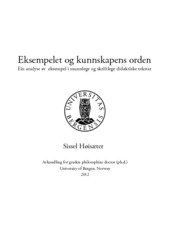| dc.description.abstract | This dissertation explores how one employs examples in a didactic context, that is to say, how it is employed in education, both orally in the classroom and in writing. To do this I have gathered twenty-two examples, put them together in a collection which I then proceed to analyze in my dissertation. My dissertation concerns examples of a narrative structure. They are linked to general theories, rules, concepts and other knowledge inherit in the given subjects. In this dissertation I define the narrative example as “a short narrative text which purpose is to clarify and/or explain the content of a concept or a generalizing text”. This study endeavours to show the different ways the narrative examples are tied to the oral and written didactic texts that they exemplify, and how the examples function in the coupling of the text. Basing my work on earlier theories of the example, I propose a model for how the example is structured and I suggest a new typology for examples. The typology is based upon how the example functions in relation to the text it exemplifies. The example-types that I make use of, are synecdochic examples, and normative and descriptive paradigms. I have classified them into nine groups based upon their source and type; and I show how in the various examples the logic text connection varies and how the examples function rhetorically in their context. The result of the analysis presented in this text can be summarized as follows: Examples appear in all disciplines and subjects, both in oral and written form, and they appear fulfilling three didactic functions which I have chosen to group as follows: “Retelling the past”, “Advice for the future” and “Illustrating the systematic content of a given subject”. Not all examples function equally efficiently, being dependent upon such things as how the relationship between the particular and general level function, where the example came from, which rhetorical role it was intended for, but also depending upon how it is told. The synecdochic example creates partitive connections to the subject it concerns, and this makes for a more complex connection then in the other two example-types. Logical connection also varies from being an inherent part of the representation of the past, to being only loosely connected to the subject matter. The paradigms however, make a generative connection with the general level. The normative paradigm is the paradigm for intended events in the future, while the descriptive paradigm is the paradigm used for general concepts. The descriptive paradigm is also the written form of an example type not included in this dissertation, the nonverbal phenomenon. When sources are concerned, surveying my material will reveal that in textbooks from the Enlightenment period internal argumentation of the text is rather closed, whereas in modern textbooks it is open while the argumentation in an oral context is even more varied. In the oral setting it is possible both to reason as a group about the example and to employ examples related to the pupils´ daily life, something that cannot be done to the same degree in written texts. Finally in my work, I mention some areas where my analysis of the example can provide a new perspective and perhaps become a basis for further research. | en_US |
